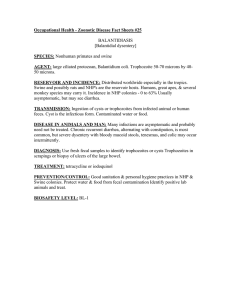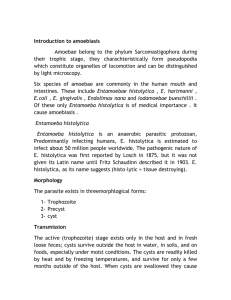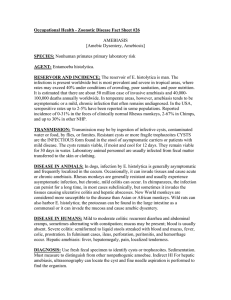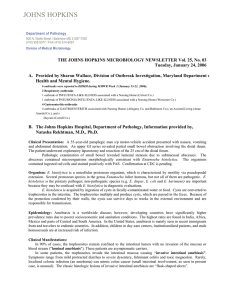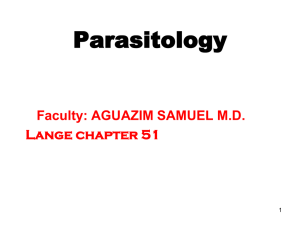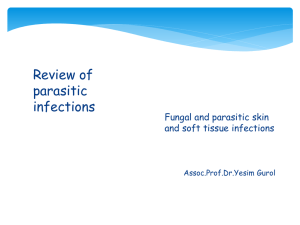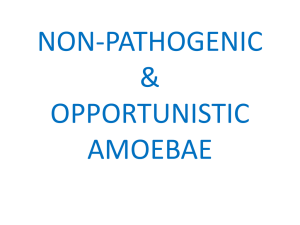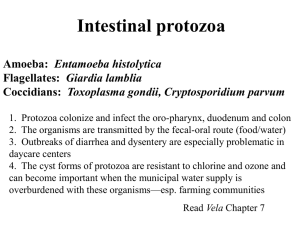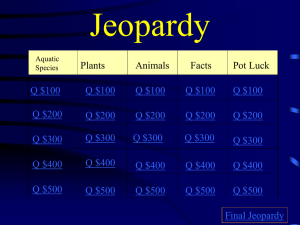Amoebiasis (Amoebic dysentery)
advertisement
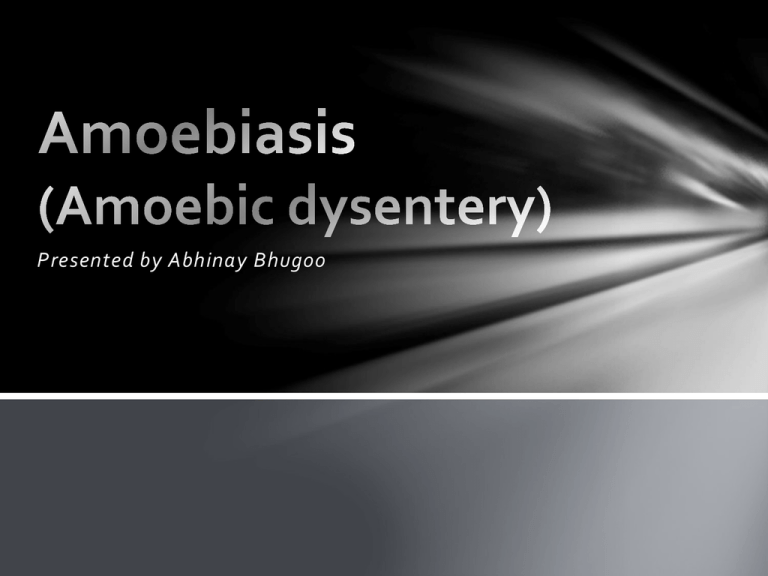
Presented by Abhinay Bhugoo Causative agent: Entamoeba histolytica Amoebiasis “Harbouring of protozoa E. histolytica inside the body with or without disease” only 10% of infected develop disease two types of infection -Extra-intestinal -Intestinal- mild to fulminant Trends of Amoebiasis Magnitude Global: - worldwide in distribution - 3rd most common parasitic death - India, China, Africa, South America - 2-60% prevalence - 100,000 deaths/year - 500 million infections - 50 million cases India: - 15% prevalence (3.6-47.4%) - variation according to sanitation Epidemiological determinants Entamoeba histolytica 7 zymodemes pathogenic two forms – - trophozoite (vegetative)-fragile - cyst -this is the infective stage • -survives for weeks if appropr. envi • -infective dose can be a single cyst source of infection is a case or carrier -1.5*107 cysts per day reservoir is only human –several years resistant to chlorine in normal conc. readily killed by freezing or heating(55°C) Incubation period: 3 days in severe infection; several months in sub-acute and chronic form. In average case vary from 3-4 weeks. Period of communicability: For duration of the illness. Modes of Transmission Faeco-oral route - contaminated water and food - direct hand to mouth Agency of flies, cockroaches, rats, etc. Sexual contact via oral-rectal contact Host All age groups affected No gender or racial differences Institutional, community living, MSW Severe if children, old, pregnant, PEM Develops antibodies in tissue invasion Environment Low socio-economic Poor sanitation, sewage seepage Night soil for agriculture Seasonal variation Host Factor Contributions Several factors contribute to influence infection 1 Stress 2 Malnutrition 3 Alcoholism 4 Corticosteroid therapy 5 Immunodeficiency 6 Alteration of Bacterial flora Risk factors • People in developing countries that have poor sanitary conditions • Immigrants from developing countries • Travellers to developing countries • People who live in institutions that have poor sanitary conditions • HIV-positive patients • homosexuals Clinical features intestinal •Asymptomatic carriers • Amoebic colitis • Fulminant colitis • Amoeboma Extra intestinal • Liver • Lung • Brain • Skin Asymptomatic carriers (non invasive form) - 90% without symptoms - does not damage lumen Invasive forms: Amoebic colitis - flask shaped ulcers superficial or deep - abd pain, diarrhoea, blood, fever - tenesmus, peri-anal ulcers Fulminant colitis - <0.5% - severely ill with high fever - intestinal bleeding - perforation - paralytic ileus Amoeboma - 1% of cases - inflammatory thickening of intestinal wall - palpable mass with trophozoites Symptoms of amoebic colitis Symptoms 1. Diarrhea 2. Dysentery 3. Abdominal pain 4. Fever 5. Dehydration 6. Length of symptoms Percentage 100 99 85 68 5 2 to 4 weeks Symptom Bacillary dysentery Amoebic dysentery Onset Acute Gradual General Condition Fever Poor Normal High grade Little fever (adult) Tenesmus Severe Moderate Dehydration Frequent Little dehydration (adult) Faeces No trophozoites Trophozoites present Culture Positive Negative Extra-intestinal Amoebic liver abcess - via portal system - 5% of invasive disease - 10 times more common in men Pleuropulmonary - direct spread from liver abcess (10%) - haematogenous spread Brain - abrupt onset & rapid progression - death in 12-72 hrs Virulence factors Trophozoites of E.histolytica interact with host through a series of steps: 1. Adhesion of target cell, phagocytosis and cytopathic effect 2. E.histolytica induces both Humoral and cell mediated immune responses. 3. Virulence factors – In many circumstances lumen dwelling Amoeba may be asymptomatic 4. Causes disease only when invade the Intestine 5. Virulence is associated with secretion of Cysteine proteniase which assists the organism in digesting the extracellular matrix and invading tissues Cysteine proteinase - Complement factor C3 It is observed Cysteine proteinase produced by invasive strains of E.histolytica inactivates the complement factor C3 and are thus resistant to Complement mediated lysis. Zymodeme Zymodeme:Populations of parasites with identical isoenzymes. Based on Electrophoretic mobility E.histolytica strains are classified into 22 Zymodemes However only 9 are invasive Invasive x Noninvasive strains The invasive and non invasive strains may appear identical may represent two distinct species 1 Invasive strain – E.histolytica 2 Non invasive strains reclassified as E.dispar. pathogenesis Clinical manifestation A. Acute amoebic dysentery Slight attack of diarrhea, altered with periods of constipation and often accompanied by tenesmus. Diarrhea, watery and foulsmelling stools often containing blood-streaked mucus. Diarrhea, watery and foulsmelling stools often containing blood-streaked mucus. Nausea, flatulence and abdominal distension, and tenderness in the right iliac region over the colon. B. Chronic amoebic dysentery Attack of dysentery lasting for several days, usually succeeded by constipation. Tenesmus accompanied by the desire to defecate. Anorexia, weight loss and weakness. Liver maybe enlarged. The stools at first are semi-fluid but soon become watery, blood, and mucoid. Vague abdominal distress, flatulence, constipation or irregularity of the bowel. Mild anorexia, constant fatigue and lassitude Abdomen lost its elasticity when picked---up between fingers. On sigmoidoscopy, scattered ulceration with yellowish and erythematous border. Gangrenous type of stool Diagnosis M/E immediately before cooling - fresh mucus or rectal ulcer swab - colourless motile trophozoites with RBC - quadrinucleated cysts Serology –IHA, ELISA - usually negative in intestinal Quadrinucleated cyst Treatment - symptomatic cases - asymptomatic in non-endemic areas - asymptomatic if food handlers Drug Metronidazole Tinidazole Kills Kills trophozoites in trophozoites intestine & tissue in intestine & tissue Dose 500-750 mg PO 600 mg bd tid x 5-10 days PO x 5 days Acts on Iodoquinol Diloxanide furoate LuminalEradicate cysts LuminalEradicate cysts 650 mg PO tid x10days 500 mg PO tid x10days Prevention & Control Primary prevention - Safe excreta disposal - Safe water supply - Hygiene - Health education Secondary - Early diagnosis - Treatment Primary prevention Sanitation Water Food hygiene -excreta -protect -protect food -wash hands -sand filter -acetic acid -latrines -boiling -detergent -food handlers examine treat educate H edu. -long term
